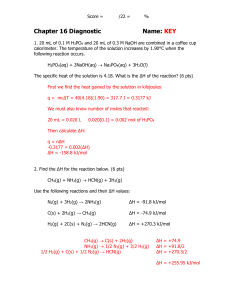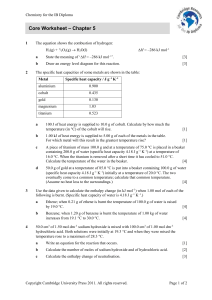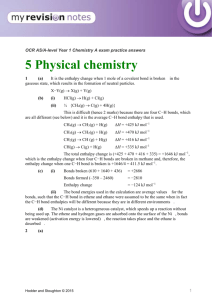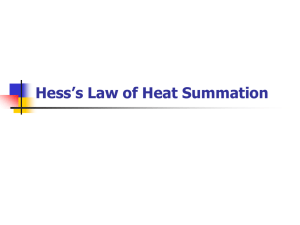Bond Enthalpy & Enthalpy of Reaction
advertisement
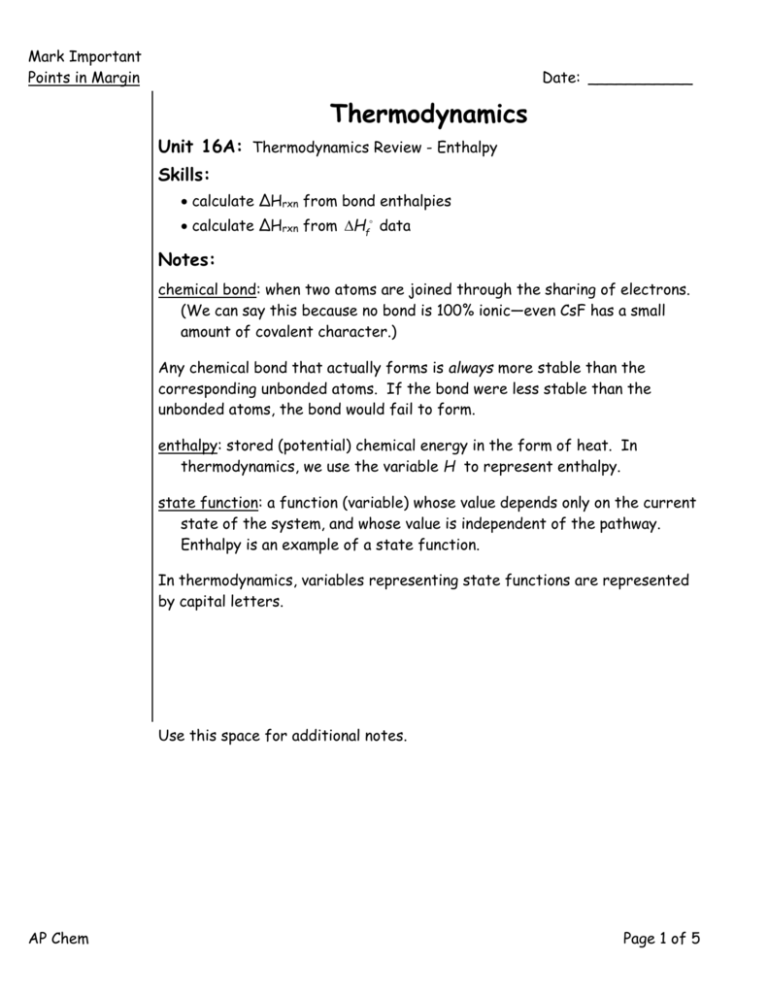
Mark Important Points in Margin Date: ___________ Thermodynamics Unit 16A: Thermodynamics Review - Enthalpy Skills: calculate ΔHrxn from bond enthalpies calculate ΔHrxn from Hf data Notes: chemical bond: when two atoms are joined through the sharing of electrons. (We can say this because no bond is 100% ionic—even CsF has a small amount of covalent character.) Any chemical bond that actually forms is always more stable than the corresponding unbonded atoms. If the bond were less stable than the unbonded atoms, the bond would fail to form. enthalpy: stored (potential) chemical energy in the form of heat. In thermodynamics, we use the variable H to represent enthalpy. state function: a function (variable) whose value depends only on the current state of the system, and whose value is independent of the pathway. Enthalpy is an example of a state function. In thermodynamics, variables representing state functions are represented by capital letters. Use this space for additional notes. AP Chem Page 1 of 5 Mark Important Points in Margin Bond Enthalpy & Enthalpy of Reaction Bond Dissociation Energies “Bond energy” is the energy required to break a chemical bond. Generally, bond dissociation energies are for homolytic dissociation (i.e., the electrons are equally split between the two atoms). Heterolytic bond dissociation energies are always higher. Here are some common heterolytic bond dissociation energies: Bond Bond Dissociation kJ Energy mol C−C 346 C=C 602 C≡C 835 C−H 411 C−O 358 C=O 799 O=O 494 O−H 459 Use this space for additional notes. AP Chem Page 2 of 5 Mark Important Points in Margin Bond Enthalpy & Enthalpy of Reaction You can use bond dissociation energies to determine the enthalpy change of a chemical reaction. For example, consider the combustion of methane: CH4 + 2 O2 → CO2 + 2 H2O This actually means: H H C H +2O O H →O C O + 2H O H break 4 C−H bonds + 2 O=O bonds → form 2 C=O bonds + 4 O−H bonds By convention, energy is positive if we put it in (endothermic), and negative if it comes out (exothermic). This means the enthalpy needed to break a bond is positive, and the enthalpy released by forming a bond is negative. Adding the energies of all of the bonds broken and formed in the equation gives the following: kJ kJ kJ kJ Hrxn 4(411 mol ) 2(494 mol ) 2(-799 mol ) 4(-459 mol ) kJ kJ kJ kJ Hrxn 1,644 mol 988 mol ( 1,598 mol ) ( 1,836 mol ) kJ kJ Hrxn 2,632 mol ( 3,434 mol ) kJ Hrxn 802 mol Use this space for additional notes. AP Chem Page 3 of 5 Mark Important Bond Enthalpy & Enthalpy of Reaction Points in Margin Enthalpy of Formation The enthalpy of formation ( Hf ) of a compound is the ΔHrxn for the formation of a compound from its elements in their natural state. For ΔHf values measured/calculated at “standard state” (usually defined to be 1 atm and 25°C), we add a superscript °. The enthalpy of formation of any pure element in its natural state is defined to be zero. For example: 2 Al (s) + 3 O2 (g) → Al2O3 (s) kJ Hrxn 1,676 mol Because Hf for Al (s) is 0, and Hf for O2 (g) is also 0, this means kJ Hf for Al2O3 (s) = Hrxn 1,676 mol Use this space for additional notes. AP Chem Page 4 of 5 Mark Important Bond Enthalpy & Enthalpy of Reaction Points in Margin Calculating ΔH rxn from Enthalpy of Formation Data Rather than calculate Hf values from bond energies, it is much more convenient to look them up in a table. Thus, for the reaction: CH4 (g) + 2 O2 (g) → CO2 (g) + 2 H2O (g) we could simply look up the Hf values for each of the compounds: Compound Hf molkJ CH4 (g) −74.8 O2 (g) 0 CO2 (g) −393.5 H2O (g) −241.8 Then: H rxn H products H reac tants kJ kJ kJ H rxn [393.5 mol 2( 241.8 mol )] [74.8 mol ] kJ kJ kJ H rxn 877.1 mol ( 74.8 mol ) 802.3 mol Use this space for additional notes. AP Chem Page 5 of 5
